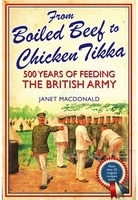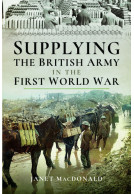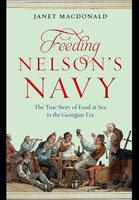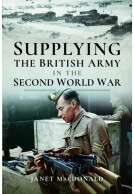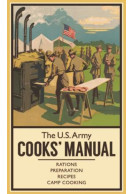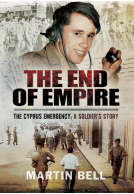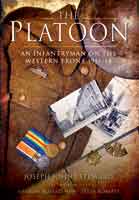Supplying the British Army in the Second World War (ePub)
Imprint: Pen & Sword Military
File Size: 1.2 MB (.epub)
Pages: 223
Illustrations: 30 illustrations
ISBN: 9781526725349
Published: 18th March 2020
| Other formats available | Price |
|---|---|
| Supplying the British Army in… Paperback Add to Basket | £11.99 |
| Supplying the British Army in… Hardback Add to Basket | £25.00 |
During the Second World War, how were the multitude of items required by the soldiers in the front line selected, ordered and delivered, and how were they produced? In this the second volume in her detailed, scholarly study of the army’s logistical system, Janet Macdonald describes the necessity for central advanced planning for each expeditionary force as well as those engaged in home defence, and the complex organization of personnel who performed these tasks, from the government and military command in London to those who distributed the equipment on the battlefield.
Armies have always required large amounts of material, but by the Second World War the numbers of men involved had grown exponentially, their equipment had become mechanized and their deployment was world wide. Elaborate planning and administration at every level had to ensure that items of all kinds were collected, transported and handed out in every theatre of the war. The scale of the operation was enormous and it had to be performed to critical timetables and was sometimes threatened by enemy action, and it was vital to the army’s success.
"A useful and accessible entry to a complex subject this is recommended."
SOFNAM - Muster - The Members' Magazine of the National Army Museum
Another splendid book here from Pen & Sword. So many books have been compiled on the experience of the British Army during World War Two, in the varied theatres of war, in Europe, North Africa and Asia. However, there is less available to digest, so readilly, which focuses solely on how the British Army operated, and how it was supplied and orchestrated. This book fills just that void further.
Jon Sandison
This book is essential reading for anyone wanting to gain an insight into the massive logistical task undertaken during the war, a task that helped shape the logistics arms of the modern British Army.
Windscreen, The Military Vehicle Trust - December 2020
A valuable read for anyone interested in logistics or World War II.
The NYMAS Review
An enthralling review of the challenges of maintaining critical logistics in a mechanized war. The process of keeping combatants supplied is a strong component in the outcome of any battle but it a much under covered topic for historians – Very Highly Recommended
Firetrench
Read the full review here
Reading this will show just how important the role of the logistician was/is when you have a fully motorised army (something the German army didn't achieve) and an influx of an extra million plus American servicemen who all had to be accommodated. Eye-watering numbers in many cases and the fact everything worked in the end is a lasting testament to all those involved from one end of the supply chain to the other. A vital role for so many servicemen, including my own father as a driver in the RASC throughout the war. Well worth reading.
Military Model Scene, Robin Buckland
Read the full review here
There are some useful facts and figures in Janet Macdonald's book which detail what it takes to actually keep the war machine fed. This is a detailed and complex subject but chapters have been thoughtfully and logically organised and there are useful sub-headings within chapters which, together with the index, make it possible to quickly find what you are looking for.
Paul Nixon
The scope of the n=book is huge because the British Army was spread over a number of different continents, but this will be an interesting introduction to the logistics of war for many and will, I suspect, entirely satisfy the majority (which includes this reviewer). A more scholarly analysis of this topic could see this type of analysis run into hundreds of pages and is probably not necessary. For those who are interested in taking this further though, there is a useful bibliography, and the author has also some helpful appendices on weights and measure, medical terms and diseases, vitamin deficiencies, and abbreviations.
I liked this book, and I can see that I shall be referring to it in future.
Read the full review here
This book to me was extremely interesting and an excellent read. I can honestly say that I learnt a lot from reading it, with a lot of surprising things along the way. Credit to the author Janet MacDonald as the read was fascinating, clear and very well explained. I can imagine it could have got boring or tedious but I didn’t find that at all. Also the thought has just occurred to me most of this job is having to be done from the front line during war. The skills of the people involved have to be really admired. I can see this book being ideal for those in business or have to organise big events. An excellent book gets my 5 star rating.
UK Historian
Read the full review here
Janet's book is especially poignant at a time when supplies of protective equipment are under such close scrutiny at the current time as we fight the corona virus. Problems of supply were, of coutrse magnified by the exponential growth of the armed forces at the beginning of the conflict, and Janet's examination of the logistics and supply problems is a terrific read.
Books Monthly
Generally when one thinks about war and the operations of armies, one thinks of the battles, the troops, the weapons, commanders and strategy. But behind the front line, all the way back to the homeland, there are activities to keep the troops in the frontline effective and supported. Not only the supply of weapons, ammo and fuel. Think of the food, the water, medication and medical troops, communication, engineering, police, managing prisoners, the population in the area, transport of all sorts of materials and loads….. think of the specialists gathering and analyzing information, making maps, designing plans. Think of all the administrative personnel needed to organize all this.
WW2 Traces
The number of tasks and skills needed behind the frontline and outside of the frontline units is baffling.
Janet Macdonald has done a great job bringing all this in perspective and we should be thankful for it.
Read the full review here
This is a really valuable book (especially for we logistics types) and is a very good companion to the author’s similar book on the logistics of the Great War. It offers a valuable insight into the sheer quantity of equipment produced and delivered. My father recounted returning a damaged Jeep to a supply compound near Caen after the Normandy landings and being astounded by the number of replacements available, and that repair was not an option; just dump it and take a new one! This book explains how this example came about.
Michael McCarthy
Michael McCarthy. Battlefield Guide
About Janet Macdonald
Janet Macdonald has published books on numerous subjects. Her first book on naval history was Feeding Nelson’s Navy: The True Story of Food at Sea in the Georgian Era; her second, the British Navy’s Victualling Board, 1793-1815: Management Competence and Incompetence. She took her MA in Maritime History at the Greenwich Maritime Institute, London, and her PhD at King’s College London, where she was awarded a Laughton Scholarship. Her thesis was on the administration of naval victualling. Her most recent books are From Boiled Beef to Chicken Tikka: 500 Years of Feeding the British Army, Sir John Moore: The Making of a Controversial Hero and Horses in the British Army 1750-1850.








